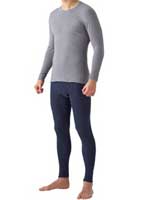Web Japan > Trends in Japan > Lifestyle > Hi-tech Winter Underwear
Hi-tech Winter Underwear
New Thermals Help to Combat Climate Change
Winters in Japan are cold, and in most regions wearing a coat is a must for protection against low temperatures. In recent years in an effort to combat global warming by conserving energy, many offices and shops have turned down the thermostats This means people need to dress up warm even indoors, but it is hard to move around and be stylish when encumbered by layer upon layer of clothing. Newly developed hi-tech underwear, which is warm but not bulky, offers the perfect solution. These garments use the wearer's body warmth to generate and retain heat efficiently. Men and women from all walks of life, including both indoor and outdoor workers, all say that once you try this underwear, you cannot wear any other kind.
Innovative Inners
The drive to make underwear more functional began some years ago. At the time of the Winter Olympics in Lillehammer, Norway, in 1994, a Japanese sporting goods manufacturer developed perspiration-wicking, exothermic material as insulation for skiwear. Three years later, when the firm launched the underwear commercially, the 12,000 pairs it had produced quickly sold out. The underwear was able to raise and maintain the temperature between the fabric and skin by two degrees Celsius using heat produced when the fibers absorb sweat.
Following this success, Japanese textile and underwear manufacturers embarked on a race to develop hi-tech underwear. They sought to raise heat-generating capabilities with new methods of weaving that expanded the moisture-absorption area. They also developed soft, thin synthetic materials that generated heat in the winter and wicked sweat in the summer, along with materials more amenable to dyeing. Their efforts ultimately paved the way for the mass production of thin, lightweight underwear. While initially the garments were popular only among athletes and outdoor enthusiasts, in time they came to be considered a good choice for everyday wear. In the fall and winter of 2007, for example, one manufacturer sold 20 million units of its hi-tech underwear in Japan.
Generating Heat
While there is some variation, all of today's technically advanced underwear works on the same basic principle, namely, harnessing the heat released when fabric absorbs moisture. The garments' capacity to retain heat has also been improved by expanding the layer of air between fabric and skin through such means as hollowing out and thinning the fibers. Many of the garments feature antibacterial and odor-fighting properties, greater elasticity to ensure a better fit, and perspiration-wicking capabilities.
The push for more hi-tech underwear continues unabated. One of the newest fabrics features special ceramic material embedded in the fibers that turns the heat from the body into radiant energy. It emits far-infrared rays that warm up the body from inside.
In Japan, a winter room temperature of 20 degrees Celsius is becoming the norm as more and more businesses respond to the government's call to lower thermostats during the cold season. The campaign, dubbed "Warm Biz," aims to cut the country's carbon dioxide emissions by reducing the amount of energy used for heating. High-tech underwear is a great way to realize this goal.
Lightweight, thin underwear enables wearers to maintain an attractive body shape and to dress smart even in cold weather. The range of available items has expanded to include undershirts, tights, leggings, and socks. In the coming years, these garments can be expected to become staples of winter underwear. (March 2009)



